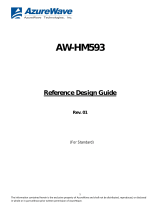
11
The information contained herein is the exclusive property of AzureWave and shall not be distributed, reproduced, or disclosed
in whole or in part without prior written permission of AzureWave.
# bt_mp_Exec 4
# bt_mp_SetParam 1,0;2,8;3,7;5,0x3F
//1,0 “0” represent Channel0,Channel range is 0~78;
//2,8 “8” represent Packet Type is 3DH5,
“2” represent Packet Type is DH5,
“5” represent Packet Type is 2DH5;
//3,7 “7” represent BT Payload is PRBS9,
“0” represent BT Payload is All0,
“1” represent BT Payload is All1,
“2” represent BT Payload is 0101;
# bt_mp_Exec 15 //Start Continue Tx
# bt_mp_Exec 17 //Stop Continue Tx
(5) BT Single Tone test command
# bt_mp_SetParam 1,0x00;2,0x08;3,0x00;4,0x00;5,0x3F;6,0xFF;7,0xFF;11,0x000000c6967e;
//1,0x00 “0x00” represent Channel0,Channel range is 0~78(this value shows Hexadecimal,0x4e represent
Channel78);
//2,0x08 “0x08” represent Packet Type is 3DH5,
“0x02” represent Packet Type is DH5,
“0x05” represent Packet Type is 2DH5;
//3,0x00 “0x00” represent BT Payload is All0,
“0x01” represent BT Payload is All1,
“0x02” represent BT Payload is 0101,
“0x07” represent BT Payload is PRBS9;
# bt_mp_Exec 34 //Start BT Single Tone
# bt_mp_Exec 35 //Stop BT Single Tone


















